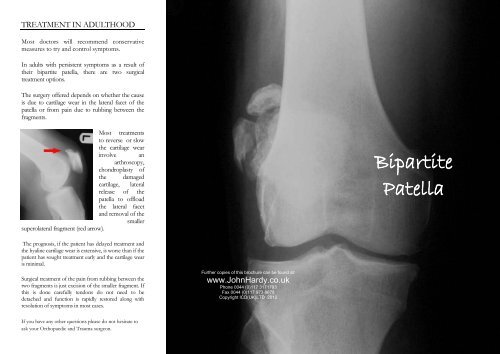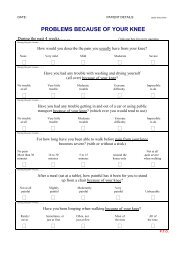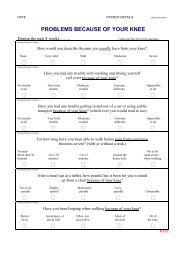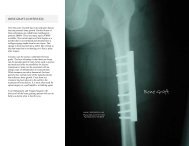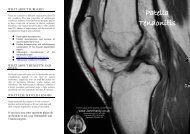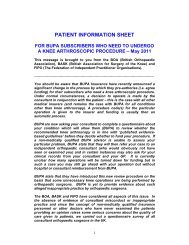Bipartite Patella Information - Knee Surgeon
Bipartite Patella Information - Knee Surgeon
Bipartite Patella Information - Knee Surgeon
You also want an ePaper? Increase the reach of your titles
YUMPU automatically turns print PDFs into web optimized ePapers that Google loves.
TREATMENT IN ADULTHOOD<br />
Most doctors will recommend conservative<br />
measures to try and control symptoms.<br />
In adults with persistent symptoms as a result of<br />
their bipartite patella, there are two surgical<br />
treatment options.<br />
The surgery offered depends on whether the cause<br />
is due to cartilage wear in the lateral facet of the<br />
patella or from pain due to rubbing between the<br />
fragments.<br />
Most treatments<br />
to reverse or slow<br />
the cartilage wear<br />
involve an<br />
arthroscopy,<br />
chondroplasty of<br />
the damaged<br />
cartilage, lateral<br />
release of the<br />
patella to offload<br />
the lateral facet<br />
and removal of the<br />
smaller<br />
superolateral fragment (red arrow).<br />
<strong>Bipartite</strong><br />
<strong>Patella</strong><br />
The prognosis, if the patient has delayed treatment and<br />
the hyaline cartilage wear is extensive, is worse than if the<br />
patient has sought treatment early and the cartilage wear<br />
is minimal.<br />
Surgical treatment of the pain from rubbing between the<br />
two fragments is just excision of the smaller fragment. If<br />
this is done carefully tendons do not need to be<br />
detached and function is rapidly restored along with<br />
resolution of symptoms in most cases.<br />
Further copies of this brochure can be found at:<br />
www.JohnHardy.co.uk<br />
Phone 0044 (0)117 3171793<br />
Fax 0044 (0)117 973 8678<br />
Copyright ICD(UK)LTD 2012<br />
If you have any other questions please do not hesitate to<br />
ask your Orthopaedic and Trauma surgeon.
BIPARTITE<br />
PATELLA<br />
This is an acquired condition of childhood. It<br />
is one of the overuse injuries that happen<br />
through excessive and sustained sporting<br />
activity in children. Athletes are never born<br />
with a bipartite patella. This is a common<br />
misconception. A bipartite patella can be seen<br />
in up to 2% of the population.<br />
The bone of the patella (knee cap) forms in<br />
cartilage of the foetal skeleton. Like most<br />
bones the patella forms from multiple<br />
centres of ossification (Ogden JA. Radiology of<br />
postnatal skeletal development. X. <strong>Patella</strong> and tibial tuberosity.<br />
Skeletal Radiol. 1984;11(4):246-57.).<br />
The process of<br />
converting the<br />
cartilage to bone<br />
begins with a centre<br />
of ossification<br />
between the ages of<br />
between three and<br />
five years. Multiple<br />
ossification centres<br />
(bone formation)<br />
form in and around<br />
the patella cartilage<br />
that rapidly<br />
coalesce. As the<br />
patellar ossification<br />
centres merge during childhood it is<br />
thought that excessive cyclic overloading by<br />
the insertion of vastus lateralis muscle into<br />
the superolateral corner of the patella (red<br />
arrow) causes accessory ossification centres<br />
that are pulled far enough apart that they do<br />
not coalesce (green arrow). These lead to<br />
the development of a bipartite (two parts)<br />
patella and rarely the tripartite (three parts<br />
as in the front<br />
radiograph).<br />
Because there is a<br />
separate fragment<br />
in the superolateral<br />
portion that then<br />
grows on the<br />
patella is often<br />
larger than a<br />
normal patella<br />
(patella magna) and<br />
it is deformed in shape. It is frequently<br />
bilateral (both knees).<br />
The bony patella expands to all cartilaginous<br />
contours during late adolescence. This is<br />
when the patella is most at risk of overuse<br />
through excessive sporting activity.<br />
SYMPTOMS IN CHILDHOOD<br />
Children complain of pain usually after sport.<br />
The pain is directly over the kneecap but not<br />
well localised. Swelling at the synchondrosis<br />
(join of the two fragments) is rare. There is<br />
often a painful range of motion of the knee.<br />
The condition settles and is rarely a problem<br />
until adulthood.<br />
SYMPTOMS IN ADULTHOOD<br />
Most are asymptomatic and found incidentally<br />
during an x-ray for another pathology. Adults<br />
start to complain of symptoms of pain and<br />
swelling of the knee in their late 30’s and 40’s.<br />
The pain is directly over the smaller fragment.<br />
This is because the bipartite smaller fragment<br />
overlaps the lateral femoral condyle and causes<br />
wear of the cartilage on the lateral facet of the<br />
patella or in the trochlea groove of the femur<br />
(thighbone). Wear of the hyaline cartilage from<br />
the lateral facet of the patella eventually<br />
proceeds to osteoarthritis.<br />
Pain is sometime due to movement between<br />
the two fragments with impingement of the<br />
two bony parts.<br />
A radiograph confirms the diagnosis. A bone<br />
scan is rarely performed but in the non<br />
arthritic but painful bipartite patellae the bone<br />
scan shows a hot spot between the fragments<br />
where they are rubbing painfully.<br />
A knee MRI will establish the state of the<br />
hyaline cartilage and the size of the fragment.<br />
TREATMENT IN CHILDHOOD<br />
In childhood, in most cases, treatment is rest<br />
and then reduction of sporting activity to the<br />
point that the symptoms do not return until<br />
skeletal maturity. The treatment of the acute<br />
phase, if there has been no wear of the patella<br />
or trochlea cartilage, is simple antiinflammatory<br />
pain killers, physiotherapy and<br />
trials of patella taping or patellofemoral knee<br />
braces.<br />
Appointments: 0044 (0)117 3171793


